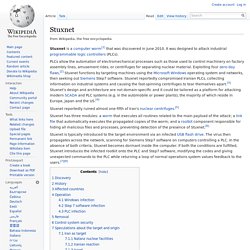

Submarine Cable Map. Stuxnet. Stuxnet is a computer worm[1] that was discovered in June 2010.

It was designed to attack industrial programmable logic controllers (PLCs). PLCs allow the automation of electromechanical processes such as those used to control machinery on factory assembly lines, amusement rides, or centrifuges for separating nuclear material. Exploiting four zero-day flaws,[2] Stuxnet functions by targeting machines using the Microsoft Windows operating system and networks, then seeking out Siemens Step7 software. Stuxnet reportedly compromised Iranian PLCs, collecting information on industrial systems and causing the fast-spinning centrifuges to tear themselves apart.[3] Stuxnet’s design and architecture are not domain-specific and it could be tailored as a platform for attacking modern SCADA and PLC systems (e.g. in the automobile or power plants), the majority of which reside in Europe, Japan and the US.[4]
Flame (malware) Flame,[a] also known as Flamer, sKyWIper,[b] and Skywiper,[2] is modular computer malware discovered in 2012[3][4] that attacks computers running the Microsoft Windows operating system.[5] The program is being used for targeted cyber espionage in Middle Eastern countries.[1][5][6] Its discovery was announced on 28 May 2012 by MAHER Center of Iranian National, Christos Papanikolaou (known as a hacker and computer programmer), Computer Emergency Response Team (CERT),[5] Kaspersky Lab[6] and CrySyS Lab of the Budapest University of Technology and Economics.[1] The last of these stated in its report that it "is certainly the most sophisticated malware we encountered during our practice; arguably, it is the most complex malware ever found.

Duqu. Duqu is a collection of computer Malware discovered on 1 September 2011, thought to be related to the Stuxnet worm.

The Laboratory of Cryptography and System Security (CrySyS Lab)[1] of the Budapest University of Technology and Economics in Hungary discovered the threat, analysed the malware, and wrote a 60-page report[2] naming the threat Duqu.[3] Duqu got its name from the prefix "~DQ" it gives to the names of files it creates.[4] Nomenclature[edit] The term Duqu is used in a variety of ways: